Authentic & Easy Thai Green Curry Chicken (Kaeng Khiao Wan) – A Taste of Thailand at Home
If you’ve ever dreamt of the vibrant flavors of Thailand, or yearn to recreate cherished memories from your travels, this recipe for Easy Green Curry Chicken is your perfect guide. Known traditionally as Kaeng Khiao Wan, which beautifully translates to “sweet green curry,” this dish is a beloved staple across the entire country. It embodies the essence of Thai cuisine with its harmonious blend of spicy, sweet, savory, and aromatic notes, making it an absolute must-try for any food enthusiast.
Our goal with this recipe is not to reinvent a classic, but rather to present it in its most authentic, yet refreshingly simple, form. This means no complicated steps or hard-to-find ingredients – just a straightforward approach to a truly local and utterly delicious Thai experience, right in your own kitchen.
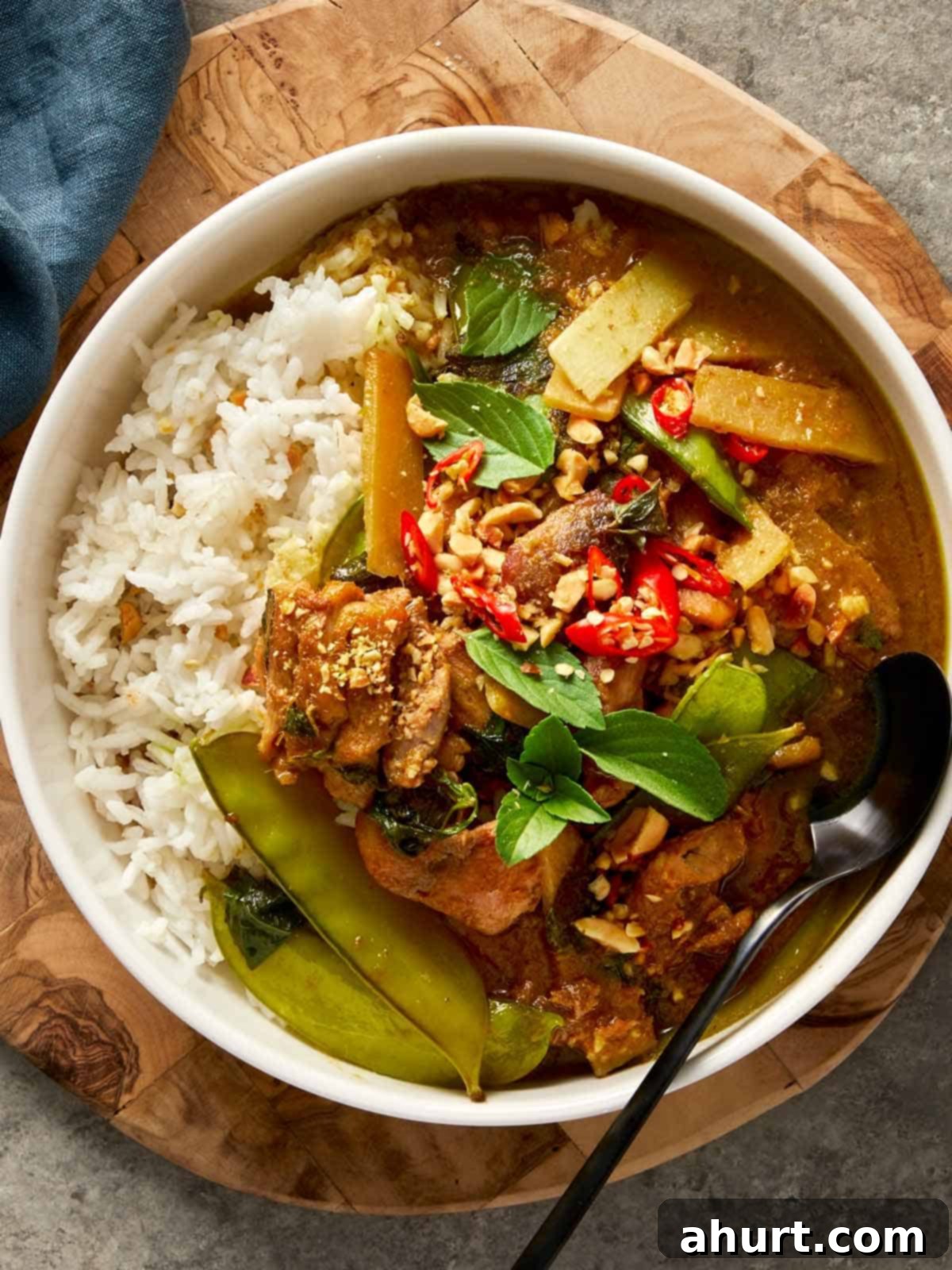
Authentic Thai Flavor, Unbelievably Fast
Don’t let the depth of flavor or the exotic name fool you; this green curry comes together surprisingly fast, tasting as though it has been simmering for hours to develop its complex profile. In an impressive 30 minutes flat, you can conjure up a dish that transports your senses directly to the bustling street food stalls of Phuket or the serene beaches of Krabi. The secret lies in a few key choices that ensure both speed and an uncompromisingly authentic taste.
First, we lean on the natural tenderness and juiciness of chicken thighs. Their higher fat content prevents them from drying out during quick cooking, ensuring every bite is moist and flavorful without the need for lengthy marination. Second, the cornerstone of this rapid authenticity is a high-quality green curry paste. While making your own paste from scratch is a rewarding endeavor, a premium store-bought paste, such as Mae Ploy, provides the foundational Thai flavors – the heat, the aromatics, and the umami – without any extra prep time. This allows you to achieve that coveted genuine Thai taste effortlessly, much like the incredible depth found in a Salmon Panang Curry.
The result is a perfectly spiced, rich, and aromatic curry that tastes like it was prepared by a seasoned Thai chef, all from the comfort of your home kitchen. It’s the ideal weeknight meal that doesn’t compromise on flavor or authenticity.
Essential Ingredients for Your Thai Green Chicken Curry
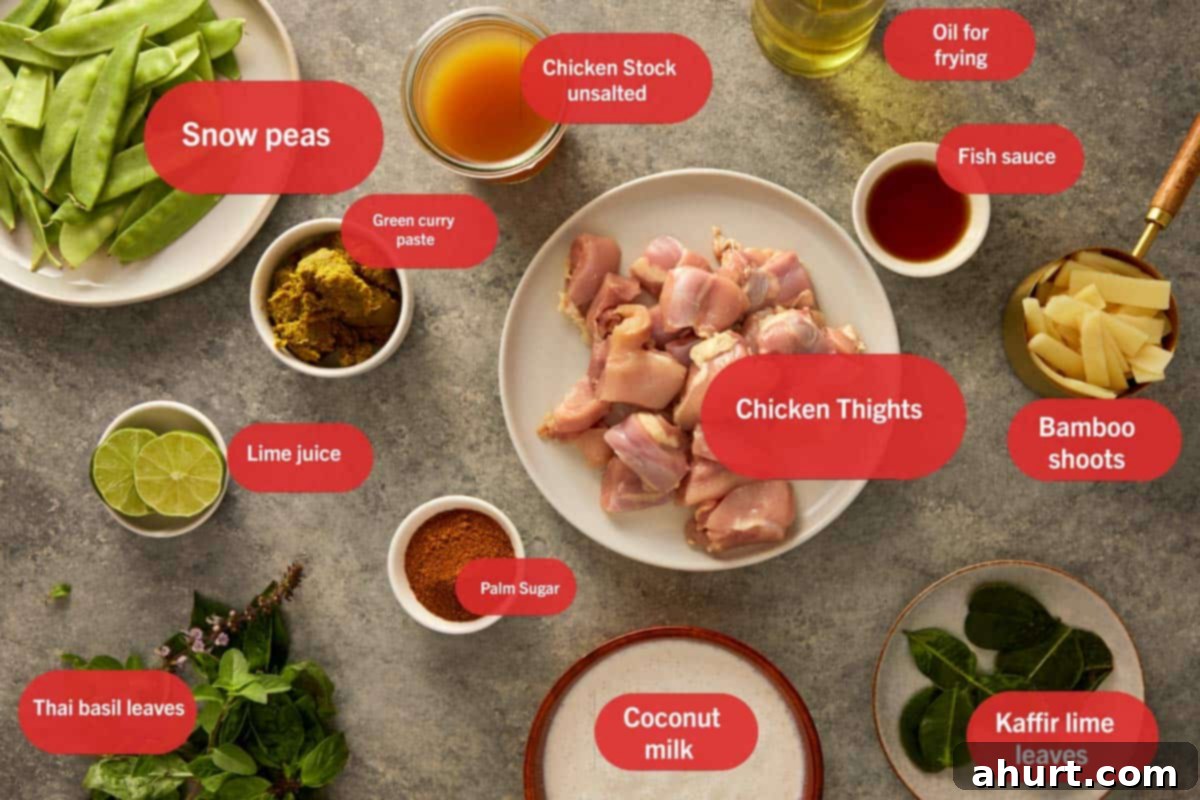
Each ingredient in a traditional Thai green curry plays a pivotal role in creating its iconic flavor profile. Here’s a closer look at what makes this dish so special:
- Chicken Thigh: When it comes to quick-cooking curries without extensive marination, chicken thigh is the undisputed champion. Its inherent fat content not only keeps the meat incredibly tender and juicy but also infuses the sauce with richer flavor as it cooks. Unlike leaner chicken breast, which can dry out easily, thighs maintain their succulent texture, making them the superior choice for this easy and authentic recipe. This is a culinary tip to remember for many of your future quick-cook dishes!
- Green Curry Paste: This is the heart and soul of your green curry. The distinct colors of Thai curry pastes (green, red, yellow) are primarily dictated by the color of the chilies used. Green curry paste, typically made with fresh green bird’s eye chilies, is generally the spiciest and boasts a vibrant, fresh, and sharp flavor profile. Red curry paste, made with dried red chilies, offers a deeper, more robust heat, while yellow curry paste, incorporating turmeric and milder yellow chilies, is usually the mildest and sweetest. For this traditional Kaeng Khiao Wan, stick to a good quality green curry paste like Mae Ploy for an authentic, fiery kick. If you prefer a milder curry, you could try starting with less paste or opt for a brand known to be less intense (like Maesri or Ayam), but be aware that substituting with yellow curry paste will significantly alter the traditional green curry flavor to something warmer, sweeter, and milder.
- Coconut Milk: A non-negotiable ingredient, coconut milk is crucial for balancing the intense spice of the green curry paste and creating that signature creamy, velvety texture. It lends a subtle sweetness that rounds out the flavors beautifully. While reduced-fat versions are available for calorie-conscious cooks, be advised that they will result in a thinner sauce and a less rich, less authentic taste. For the true Thai experience, full-fat coconut milk is highly recommended.
- Bamboo Shoots: These earthy, crunchy additions are fantastic flavor sponges in any curry. Since we’re not marinating the chicken extensively, the bamboo shoots readily absorb the rich, aromatic sauce, offering bursts of savory flavor in every bite. While canned bamboo shoots are convenient, seeking out fresh bamboo shoots from your produce department will elevate the dish significantly. Fresh bamboo offers a crisper, more satisfying crunch that canned varieties often lack, adding a wonderful textural contrast that truly enhances the overall experience. Ensure to rinse canned bamboo shoots thoroughly before use to remove any metallic taste.
- Kaffir Lime Leaves: Essential for their distinctive, bright citrus aroma that is uniquely Thai. These leaves infuse the curry with an unparalleled freshness and depth. Slightly bruising them before adding helps release their aromatic oils.
- Fish Sauce: This staple Thai condiment provides a crucial layer of umami and savory depth, balancing the sweet and spicy elements. It’s the primary source of saltiness in the curry, so adjust to your preference.
- Palm Sugar: Authentic Thai curries expertly balance all five flavor profiles: sweet, sour, salty, spicy, and umami. Palm sugar provides a nuanced, caramel-like sweetness that is far superior to granulated sugar, harmonizing the spiciness and richness of the curry.
- Chicken Stock: Used to thin the curry to the perfect consistency and provide a flavorful liquid base. Unsalted stock allows you to control the overall saltiness with the fish sauce.
- Snow Peas: Adding a touch of vibrant green and a fresh, crisp texture, snow peas cook quickly and absorb the curry flavors beautifully.
- Lime Juice & Thai Basil Leaves: These are added at the very end to provide a final burst of freshness, acidity, and aromatic complexity, brightening the entire dish just before serving.
Note: The full, precise list of ingredients and their exact measurements can be found in the detailed Recipe Card below.
Your Simple Step-by-Step Guide to Perfect Green Curry
Creating this authentic Thai green chicken curry is surprisingly straightforward. Follow these easy steps to achieve a truly delicious meal:
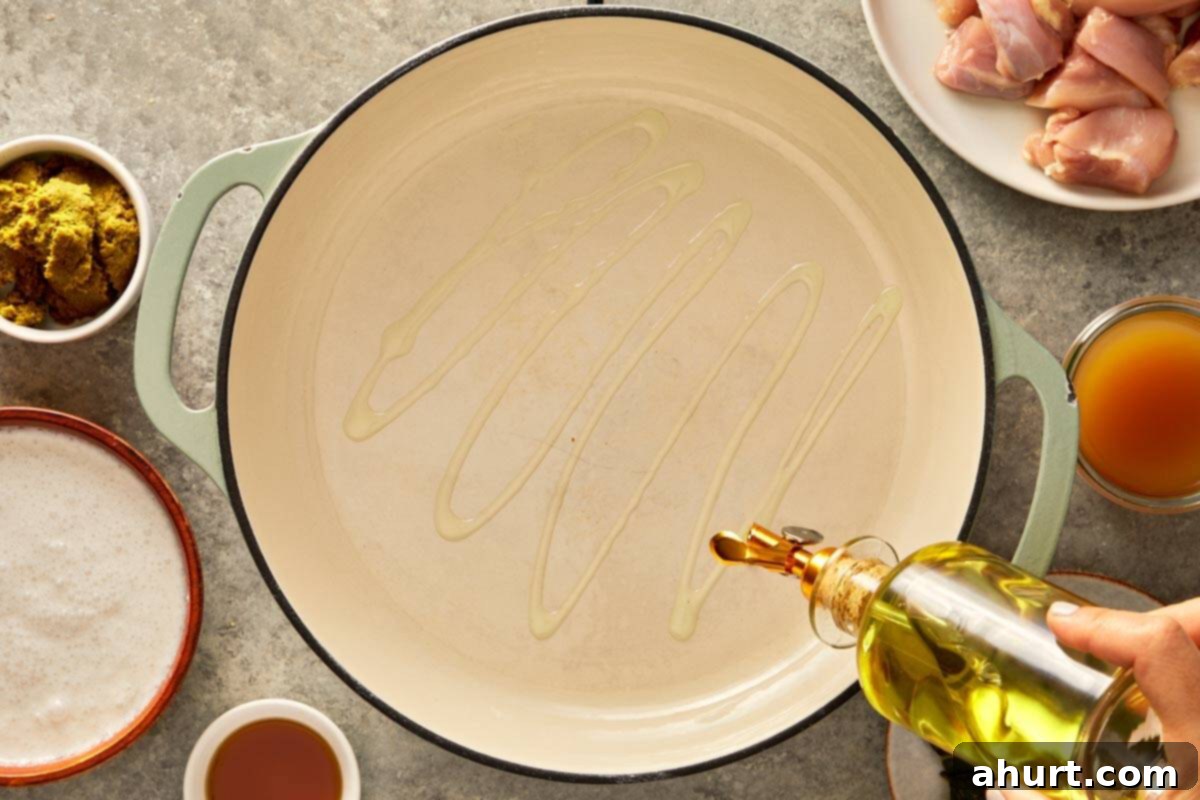
- Heat the Oil: Begin by heating 1 tablespoon of your preferred cooking oil in a medium-sized pan or wok over medium-high heat. Ensure the oil is shimmering before adding the chicken, which helps achieve a nice sear.
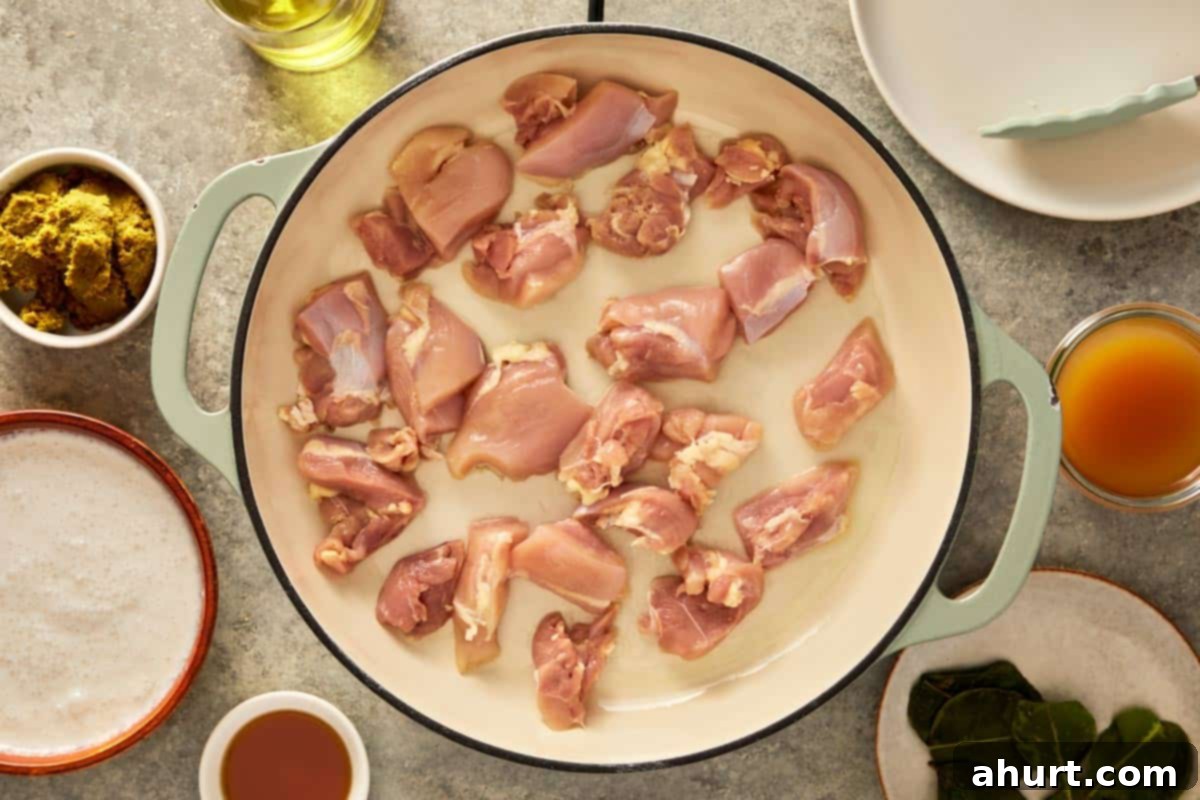
- Sauté the Chicken: Add the bite-sized chicken thigh pieces to the hot pan. Sauté them for 2–3 minutes, stirring occasionally, until they are lightly golden on the outside. They don’t need to be fully cooked through at this stage, just nicely browned for flavor.
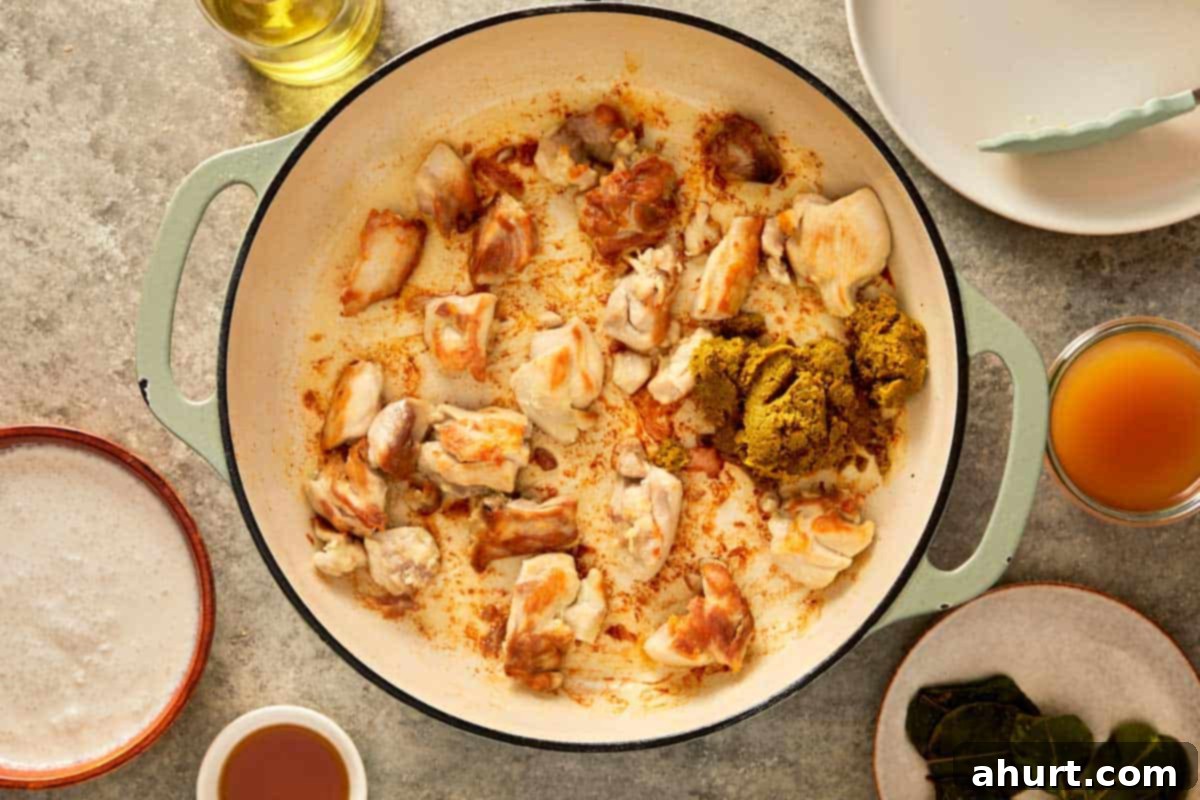
- Add Curry Paste: Reduce the heat slightly, then stir in the green curry paste with the chicken. Cook for just 1 minute, allowing the paste to warm through and release its incredible aromatics. Be careful not to burn it.
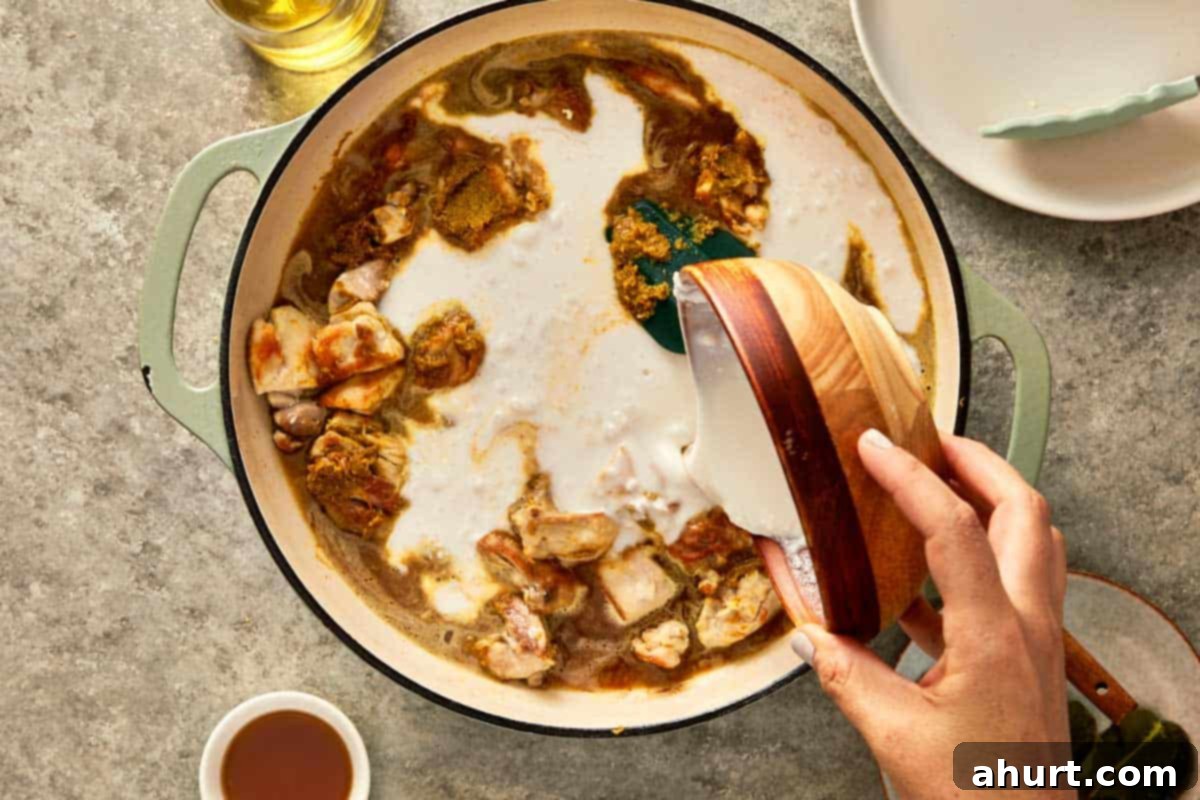
- Simmer the Sauce: Pour in the chicken stock and coconut milk. Add the palm sugar, fish sauce, and kaffir lime leaves. Stir everything well to combine. Bring the mixture to a gentle simmer, then reduce the heat to low and let it cook gently for 10 minutes. This simmering time allows the flavors to meld beautifully and the chicken to cook through.
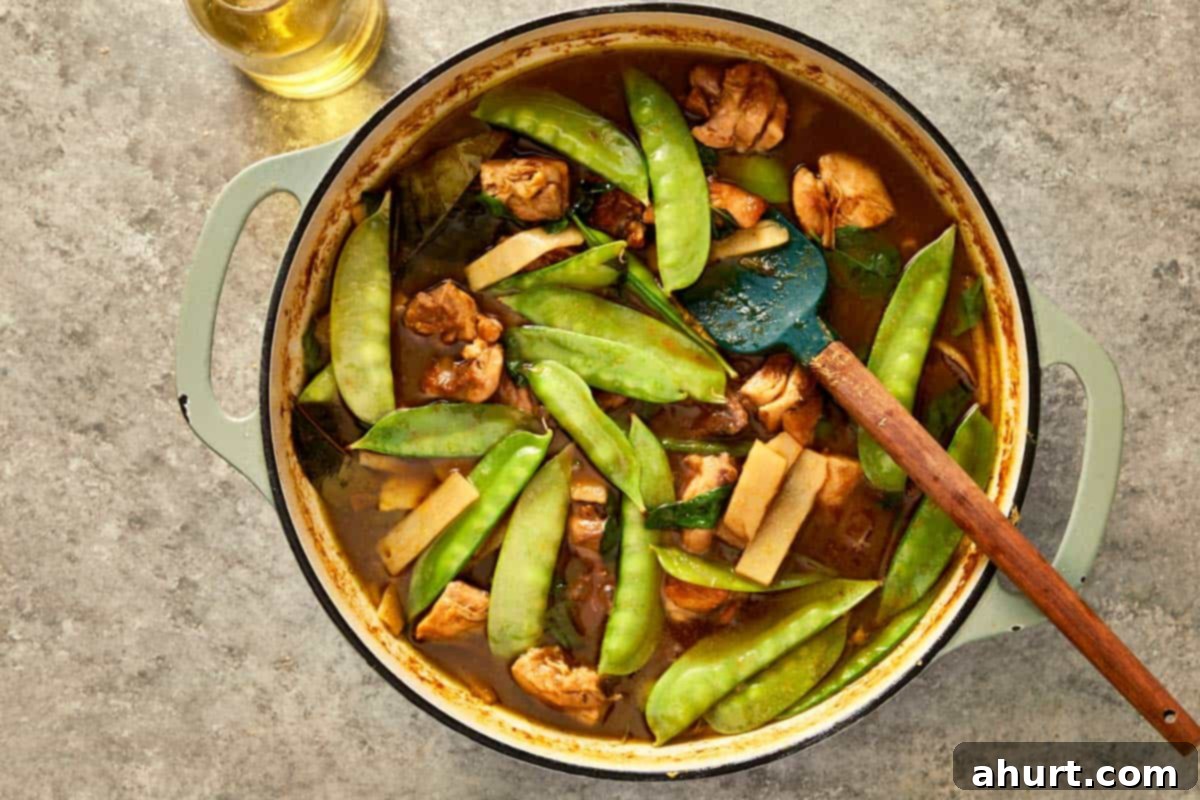
- Add Vegetables: Stir in the bamboo shoots and snow peas. Cook for another 3 minutes, just until the vegetables are tender-crisp and have absorbed some of that delicious curry sauce.
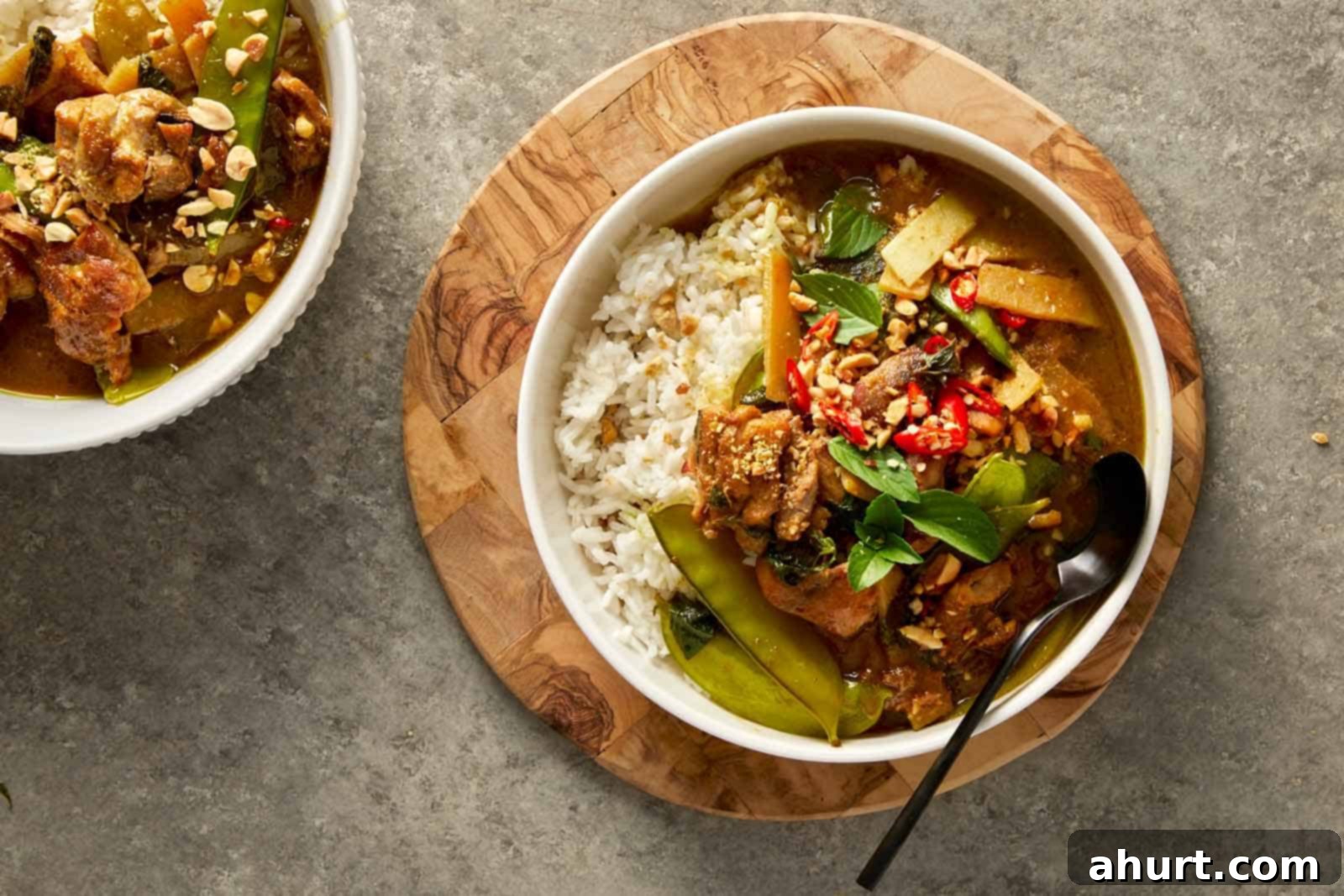
- Finish and Serve: Remove the pan from the heat. Stir in the fresh lime juice and a generous handful of fresh Thai basil leaves. The residual heat will wilt the basil and release its fragrant oils. Stir gently and serve your authentic Thai Green Chicken Curry hot.
Perfect Pairings: What to Serve with Green Chicken Curry
A truly complete Thai meal isn’t just about the curry; it’s about the harmonious combination of flavors and textures that sides provide. While this Green Chicken Curry is a star on its own, pairing it with the right accompaniments elevates the entire dining experience.
Undoubtedly, the most authentic and quintessential pairing is with fluffy, fragrant Jasmine Rice. This long-grain rice, native to Thailand, is known for its delicate aroma, slightly sticky texture, and light, airy consistency when cooked properly. Its subtle floral notes perfectly complement the rich and spicy curry, absorbing the delicious sauce and making every bite a delight. For optimal fluffiness, consider using a rice cooker.
Beyond Jasmine rice, there are other wonderful options. For an authentic street food experience, try serving this curry with Kanom Jeen, a type of fresh Thai rice noodle. These thin, vermicelli-like noodles offer a delightful chewy texture and are a fantastic alternative to traditional rice, especially if you’re looking to explore different traditional pairings.
If you’re looking for more familiar side dishes that still complement the curry beautifully, consider light and refreshing options. Simple steamed or sautéed green vegetables like green beans or asparagus can cut through the richness of the curry. For those who enjoy a fuller meal, sides like Garlic Butter Rice, Fried Rice With Bacon, Buttery Sautéed Green Beans, or Cheesy Garlic Roasted Asparagus can also be delicious, adding an extra layer of flavor and satisfaction to your meal.
To brighten the palate, a simple side salad with a light vinaigrette can also be a wonderful addition, offering a crisp, fresh contrast to the warm and spicy curry.
Recipe FAQ’s for Your Green Curry Journey
Thai Green Curry is typically known for being quite spicy, often leaning towards medium-hot to hot. However, the exact heat level can vary significantly depending on the brand of green curry paste you choose. Brands like Mae Ploy are renowned for their authentic, robust, and spicier profiles, which is why we recommend it for a truly traditional taste. Milder options like Maesri or Ayam are available if you prefer less heat. A good strategy is to start with less paste than recommended, taste the sauce after it has simmered, and then add more if you desire a fiercer kick.
While you technically can, we strongly advise against it for this specific recipe. Chicken breast is much leaner than thigh, and without a lengthy marination, it tends to dry out quickly and absorb less flavor during the fast cooking process. The natural fat in chicken thighs is crucial for keeping the meat tender and juicy, and it contributes significantly to the richness of the curry sauce. If you must use chicken breast, we recommend cutting it into slightly larger chunks and being very careful not to overcook it. You might also consider a quick 15-minute marinade in a little fish sauce and a pinch of sugar to help it retain moisture and flavor.
Absolutely! Green curry is one of those magical dishes that often tastes even better the next day. As it rests, the complex flavors deepen and meld together further, creating an even more harmonious and rich experience. Store your leftover curry in an airtight container in the refrigerator for up to 3 days. When reheating, do so gently over low heat on the stovetop. If the sauce has thickened too much overnight, add a small splash of chicken stock or coconut milk to reach your desired consistency.
Kaffir lime leaves provide a unique, intensely fragrant citrus note that is hard to fully replicate. However, if fresh or frozen kaffir lime leaves are unavailable, you can substitute with the zest of one regular lime. While it won’t be an exact match, it will still provide a pleasant citrusy aroma that complements the curry well. Dried kaffir lime leaves can also be used, but you might need a few more, and their flavor will be milder.
Yes, absolutely! Thai green curry is very versatile when it comes to vegetables. Feel free to add your favorites. Popular additions include sliced bell peppers (red, yellow, or green), green beans, zucchini, mushrooms, baby corn, or even eggplant. Add harder vegetables like carrots or potatoes earlier during the simmering process, and softer ones like bell peppers or mushrooms during the last few minutes of cooking with the bamboo shoots and snow peas to prevent them from becoming mushy.
Transforming this dish into a vegetarian or vegan delight is simple! Substitute the chicken with firm tofu (pressed and cubed, then lightly pan-fried for texture), tempeh, or a mix of hearty vegetables like cauliflower and broccoli florets. Replace chicken stock with vegetable stock. For a vegan version, ensure your green curry paste does not contain shrimp paste (many brands offer vegan options) and swap fish sauce for a vegan fish sauce alternative or a dash of soy sauce mixed with a squeeze of lime juice.
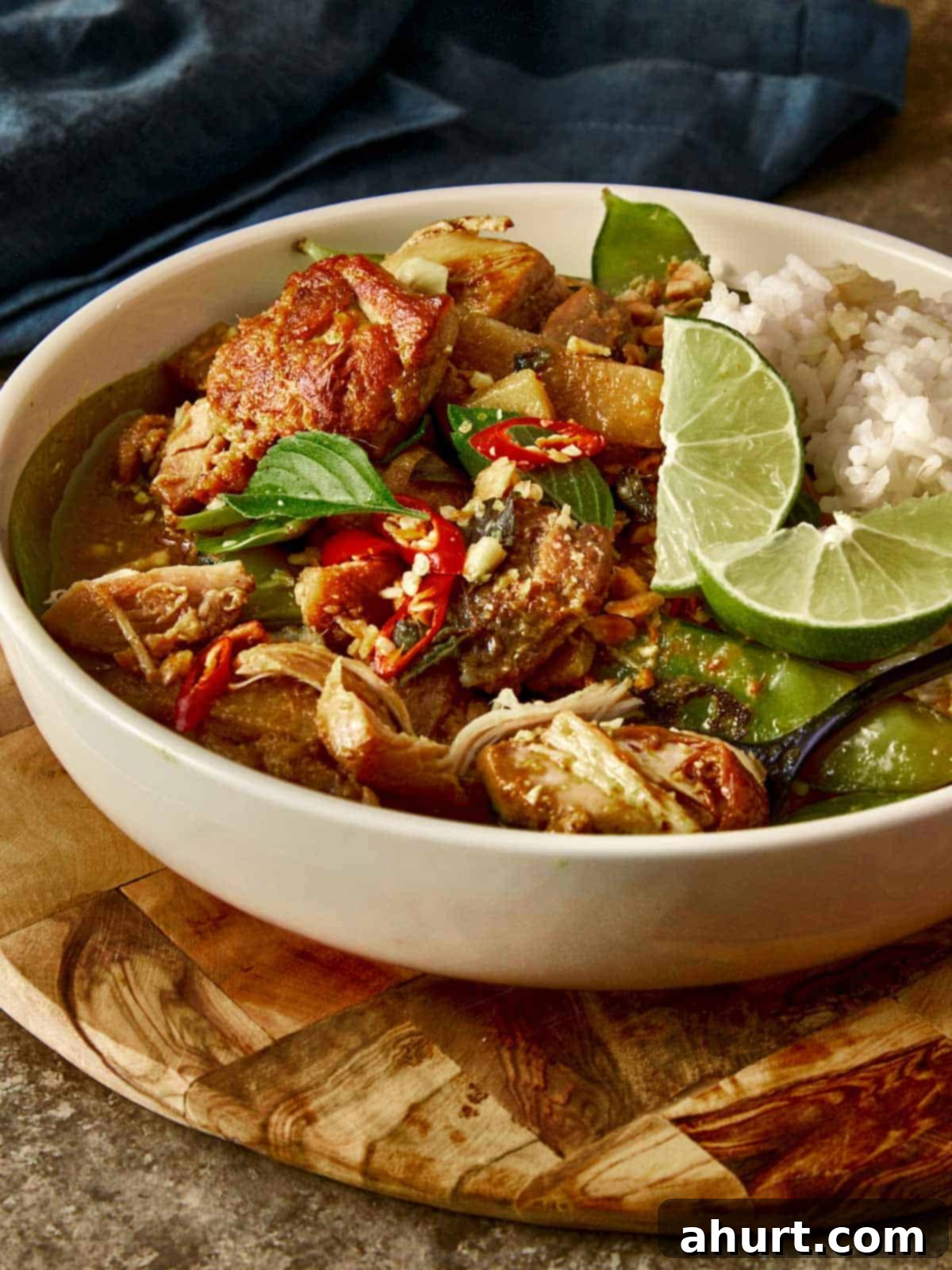
Watch It Being Made!
Sometimes, seeing is believing, and watching a recipe come to life can be incredibly helpful. For a visual guide to making this delicious Thai Green Chicken Curry, check out our step-by-step video:

Pin
Thai Green Chicken Curry
Ingredients
- 1 tbsp oil (for frying)
- 1.5 lbs chicken thigh cut into bite-sized pieces
- 4 tbsp green curry paste Mae Ploy or similar
- 1 1/2 cup chicken stock unsalted
- 2 1/2 cups coconut milk
- 2 tbsp palm sugar
- 2 tsp fish sauce
- 5 kaffir lime leaves
- 1 cup bamboo shoots
- 1 cup snow peas
- 2 tsp lime juice
- 1 1/2 cups Thai Basil Leaves
Instructions
-
Heat oil in a medium-sized pan over medium-high heat.
-
Add chicken pieces and sauté for 2–3 minutes until lightly golden.
-
Stir in curry paste and cook for 1 minute.
-
Add chicken stock, coconut milk, palm sugar, fish sauce, and kaffir lime leaves. Reduce heat and simmer gently for 10 minutes.
-
Add bamboo shoots and snow peas, stir well, and cook for another 3 minutes.
-
Finish with lime juice and Thai basil leaves. Stir and serve hot.
Notes
- Curry Paste: Mae Ploy is quite strong and flavourful. If using a milder brand, add an extra tablespoon to intensify the flavour. For an authentic taste, choosing a good quality green curry paste is key, as it provides the foundational aromatics and heat.
- Adjusting Spice: The heat of Thai curry paste varies by brand. If you’re sensitive to spice, start with less paste (e.g., 3 tbsp) and taste after simmering before adding more. You can always add a pinch of chili flakes later if desired.
- Coconut Milk Tip: For a truly creamy, restaurant-style curry with rich flavor and a thick sauce, use full-fat coconut milk. Light versions will result in a thinner consistency and less depth of flavor.
- Protein Options: This recipe is incredibly versatile. Feel free to substitute chicken with prawns (add in the last 2-3 minutes of simmering), firm tofu or tempeh (pan-fry before adding to the curry), or thinly sliced beef (cook until tender). Adjust the cooking time accordingly to ensure your chosen protein doesn’t overcook.
- Storage: Leftovers are fantastic! Store your cooled curry in an airtight container in the fridge for up to 3 days. Reheat gently on the stovetop over low heat, stirring occasionally. If the sauce has thickened too much upon reheating, add a splash of chicken stock or coconut milk to thin it to your preferred consistency.
- Freezing: The curry base (without the final addition of snow peas, bamboo shoots, and fresh basil) freezes exceptionally well. Allow it to cool completely, then transfer to freezer-safe containers for up to 2 months. Thaw overnight in the fridge, then reheat gently on the stove, adding fresh vegetables and basil at the end to finish the dish.
Nutrition
Nutrition information is automatically calculated, so should only be used as an approximation.
